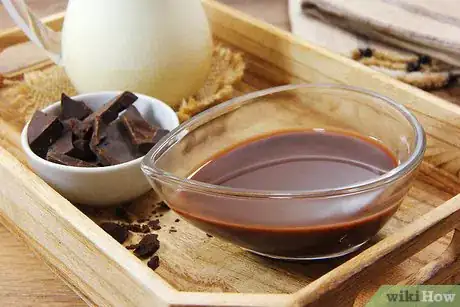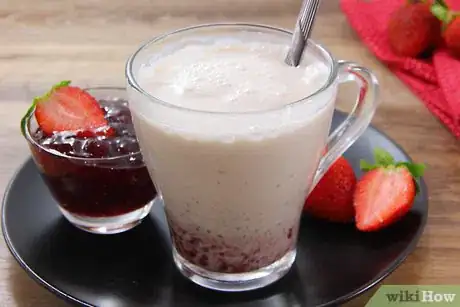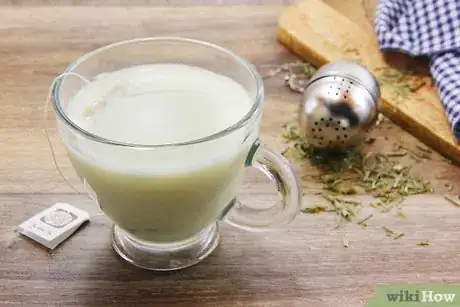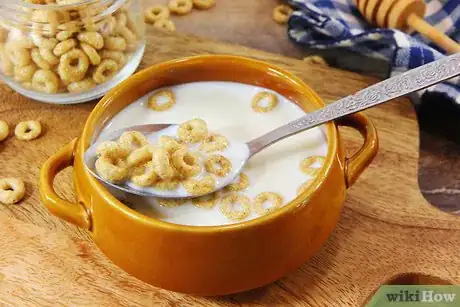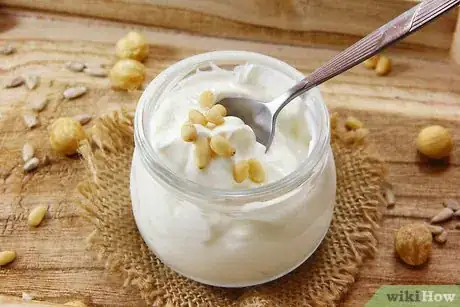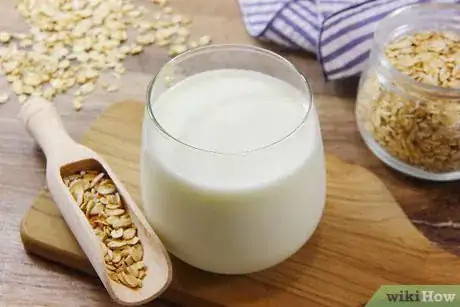This article was co-authored by Claudia Carberry, RD, MS and by wikiHow staff writer, Jennifer Mueller, JD. Claudia Carberry is a Registered Dietitian specializing in kidney transplants and counseling patients for weight loss at the University of Arkansas for Medical Sciences. She is a member of the Arkansas Academy of Nutrition and Dietetics. Claudia received her MS in Nutrition from the University of Tennessee Knoxville in 2010.
There are 8 references cited in this article, which can be found at the bottom of the page.
wikiHow marks an article as reader-approved once it receives enough positive feedback. In this case, 80% of readers who voted found the article helpful, earning it our reader-approved status.
This article has been viewed 211,777 times.
Milk and other dairy products are the best sources for calcium and Vitamin D, necessary nutrients for strong, healthy bones – this is why people over the age of 2 are encouraged to drink 1% or skim milk daily.[1] However, this can be difficult if you hate the taste, smell, or consistency of milk and feel like you have to choke it down. If you don't like milk, there are ways you can disguise the taste, smell, and texture to make it easier for you to drink it. If none of those tricks work, you might consider using a milk substitute.[2]
Steps
Adding Flavors to Milk
-
1Stir in chocolate or strawberry syrup. Your local grocery store likely carries pre-made chocolate or strawberry milk. However, if you mix in your own syrup you can control the flavor better by adding as much syrup as suits your taste.[3]
- Start by adding a small amount of syrup and stirring it vigorously. When that syrup is thoroughly dissolved in the milk, give it a taste and see if you want to add more. If you squeeze in a large amount of syrup at once, you'll just end up with a lot of syrup pooled at the bottom of your glass.
Variation: If syrups are too sweet for you, try honey instead. There are a variety of types of flavored and herbal honey available. Try different combinations until you find one you like.
-
2Add your favorite flavor of fruit jam or preserves. Jams and preserves mix with milk fairly easily and can add a sweet flavor that disguises the taste of the milk. Thicker jams or preserves will also alter the texture.[4]
- Highly acidic fruit, particularly citrus, kiwi, and pineapple, will curdle milk. The milk is still technically safe to drink. However, if you already dislike milk this will likely make your problem worse.
Advertisement -
3Steep a tea bag in your milk. Plenty of tea drinkers add milk to their tea, but you can also do it the other way around. The flavors in the tea will be absorbed by the milk, which may make it more palatable to drink.[5]
- Chai tea is a particularly good flavor to mix with milk. Herbal teas can also provide an interesting flavor combination. Experiment until you find one you like.
-
4Make hot cocoa with milk instead of water. Hot cocoa can be a relaxing and indulgent treat when cold weather hits. If you're using a powdered hot cocoa mix, heat milk and stir it into the powdered mix.
- The easiest way to heat your milk is in the microwave. It shouldn't take more than 45 seconds to a minute for your milk to be warm enough for hot cocoa. You don't need to bring it to a boil.
Mixing Milk with Other Foods
-
1Dunk bread or cookies into milk. Instead of simply drinking the milk on its own, dip a cookie or a piece of bread in it to soak up the milk, then eat the part you dipped. Before you know it, your milk will be gone.[6]
- Bread will be healthier for you than cookies if you plan to do this every day.
- You can also use biscotti, which is designed to be dunked in liquid before eating. There are many varieties of biscotti that aren't nearly as packed with sugar as cookies are.
Did You Know? Dampening cookies or other baked goods allows for quicker and easier release of chemical compounds responsible for the flavor – so cookies and other baked goods may actually taste better when they're dunked.
-
2Make instant oatmeal with milk instead of water. If you have instant oatmeal for breakfast, you can use milk instead of water when you mix it. You likely won't taste the milk at all. If anything, your oatmeal may taste even better.
- Follow the instructions on the package carefully if you're using milk instead of water. Some brands require you to heat the milk separately and then stir in the oatmeal, while others require the milk and oatmeal to be heated together.
-
3Have the classic milk and cereal for breakfast. Dry cereal in milk is a classic combination and also a way to get your milk in. Different types of cereal may also work to flavor the milk, so it doesn't taste like regular milk.[7]
- Sugary cereals will typically disguise the taste of the milk the best. They're not as healthy for you to eat on a regular basis, but they're fine as a treat. Chocolate cereals will turn your milk into chocolate milk.
- Don't be afraid to combine tactics! For example, you might try cereal with slices of fruit and flavored milk.
-
4Add milk to homemade milkshakes or smoothies. Choose ingredients with flavors you enjoy, preferably a mix of both fruits and vegetables. Combine everything in a blender, then add 1 cup (8 fluid ounces or 240mL) of milk. Pulse until smooth.[8]
- Some fruits, especially kiwis and fresh pineapples, may curdle the milk. The smoothie should be fine if you drink it right away. However, if you prepare a large amount in advance and leave it in the fridge, it will go bad.
-
5Stir milk into soups or casseroles. There are plenty of recipes, especially for casseroles and other baked goods, that already call for milk. Even if the recipe itself doesn't call for milk, you can typically substitute milk for other liquid ingredients without having any problems.[9]
- For example, if you're making a condensed soup, such as tomato, from a can, you can add a can of milk instead of a can of water. It won't alter the flavor of the soup itself, and you may find you like the texture of the soup better.
- If you're eating a ready-to-eat canned soup that doesn't require you to add water, adding milk is probably not a good idea. However, if it's a chowder or cream-based soup, you can typically add a little bit of milk – it will just make the soup a little thinner.
Getting Calcium from Other Sources
-
1Try other dairy products instead of milk. Other dairy products such as yogurt and cheese have about the same amount of calcium as milk does. Even ice cream provides significant amounts of calcium, although it's something you should eat in moderation.[10]
- For example, you might have a serving of yogurt with your breakfast and a grilled cheese sandwich for lunch.
- If you don't like milk in your cereal either, you can also mix your cereal into yogurt instead.
-
2Add foods to your diet that are fortified with calcium and Vitamin D. There are many other foods and drinks, including cereals and orange juice, that have calcium added to them. Check the container for a label indicating the food or drink has been fortified.[11]
- You can also check the calcium and Vitamin D amounts per serving on the nutritional label.
Tip: Vitamin D is necessary for your body to absorb calcium, so make sure the foods or drinks you consume as a substitute for milk are fortified with both. Women and men under the age of 50 should have between 400 and 800 International Units (IUs) of Vitamin D daily, along with at least 1,000 mg of calcium.
-
3Drink calcium-fortified non-dairy milk. If you dislike milk, you may find an alternative milk that you do like and can drink as a substitute. There are many different varieties of non-dairy milk, including almond milk, soy milk, coconut milk, oat, hemp, and cashew milk.[12]
- The point of including milk in your diet is to get calcium and Vitamin D. Check the labels of alternative milk carefully and make sure they include the nutrients you need.
-
4Eat leafy greens such as spinach and kale. Leafy greens have a high content of both calcium and Vitamin D. If you simply can't stomach drinking milk, these can serve as good substitutes. They can also be easily integrated into basically any meal.
- You can eat leafy greens as a side dish, use them on sandwiches, or stir them into soups or casseroles.
- For breakfast, try scrambling eggs with spinach, or make a spinach and mushroom omelet. You can also blend spinach or kale into a breakfast smoothie.
- Be aware that you will not absorb the nutrients from these plant sources as well as you would from an animal source. However, there are many other benefits to eating these foods, so it is worth incorporating them!
-
5Substitute salmon for tuna. If you regularly eat canned tuna, such as in a tuna salad or casserole, use canned salmon instead. Salmon is a good source of both Vitamin D and calcium. Although salmon and tuna do have different flavors, salmon still works with most of the same flavors tuna does.[13]
- When substituting canned salmon in a recipe that calls for canned tuna, the amount of canned salmon you use remains the same.
Warnings
- If drinking milk causes nausea, cramps, or diarrhea, you may be lactose intolerant. Make an appointment with your healthcare provider to get an official diagnosis and discuss treatment options.[14]⧼thumbs_response⧽
References
- ↑ https://www.choosemyplate.gov/dairy
- ↑ https://health.clevelandclinic.org/child-wont-drink-milk/
- ↑ https://www.eatright.org/food/nutrition/dietary-guidelines-and-myplate/dairy-alternatives-for-kids-who-wont-or-cant-drink-milk
- ↑ https://www.dairydiscoveryzone.com/blog/6-fun-ways-flavor-your-milk-dietitian-approved
- ↑ https://www.dairydiscoveryzone.com/blog/6-fun-ways-flavor-your-milk-dietitian-approved
- ↑ https://www.thekitchn.com/how-to-make-your-cookies-taste-better-186856
- ↑ https://www.eatright.org/food/nutrition/dietary-guidelines-and-myplate/dairy-alternatives-for-kids-who-wont-or-cant-drink-milk
- ↑ https://blogs.ext.vt.edu/eatsmart-movemore/2014/04/03/all-about-smoothies/
- ↑ https://www.eatright.org/food/nutrition/dietary-guidelines-and-myplate/dairy-alternatives-for-kids-who-wont-or-cant-drink-milk
- ↑ https://health.clevelandclinic.org/child-wont-drink-milk/
- ↑ https://radiomd.com/allina/item/29722-but-i-hate-milk-strong-bones-without-the-dairy
- ↑ https://www.eatright.org/food/nutrition/dietary-guidelines-and-myplate/dairy-alternatives-for-kids-who-wont-or-cant-drink-milk
- ↑ https://www.eatright.org/food/nutrition/dietary-guidelines-and-myplate/dairy-alternatives-for-kids-who-wont-or-cant-drink-milk
- ↑ https://my.clevelandclinic.org/health/diseases/7317-lactose-intolerance
About This Article
If you hate milk but you need to drink it anyway, try stirring in chocolate or strawberry syrup to disguise the taste. Stir the syrup vigorously into the milk; otherwise, it might just settle on the bottom of the glass. If you’d prefer a warm drink, heat the milk for about 45 seconds in the microwave, then stir powdered hot cocoa mix into the glass. If you still don’t like drinking milk, try making a big bowl of cereal with milk instead! Keep reading to learn other ways you can use milk when you’re cooking, like how to add it to soup!
